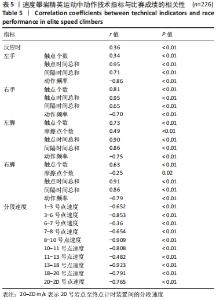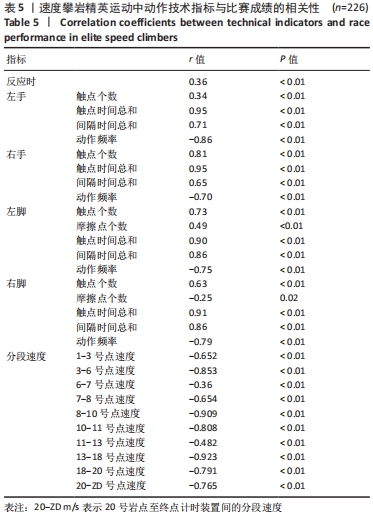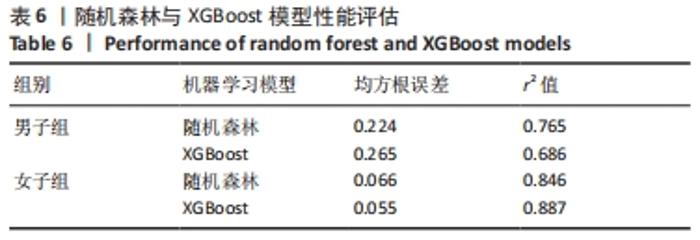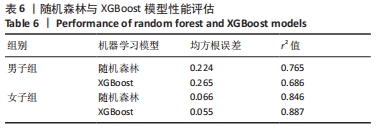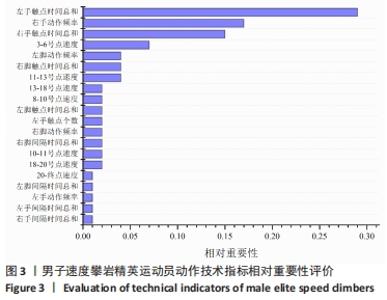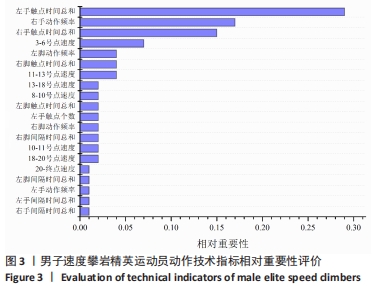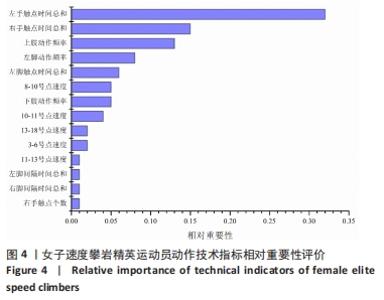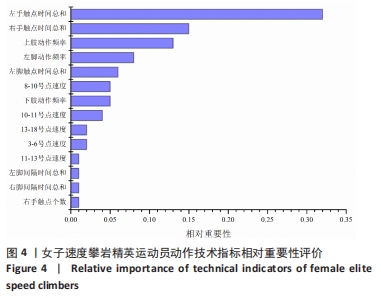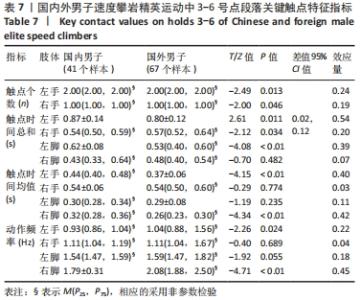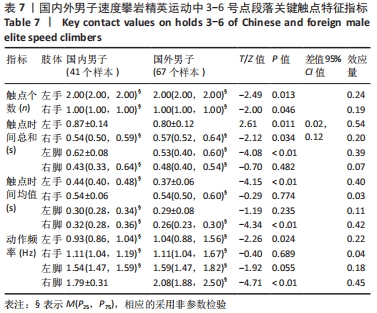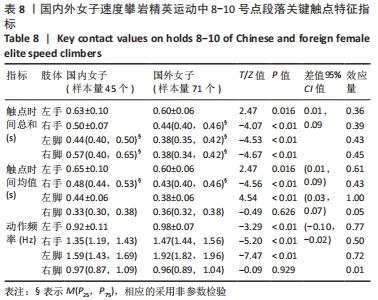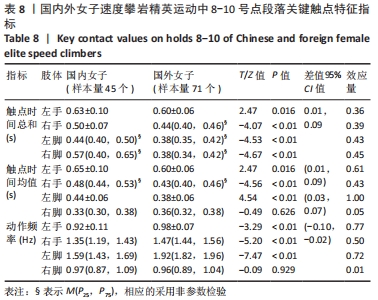[1] INTERNATIONAL FEDERATION OF SPORT CLIMBING. Olympic Games Paris 2024[EB/OL]. [2022-1-20]. https://www.ifsc-climbing.org/index.php/olympic-games/paris-2024.
[2] 李元,田兵兵.东京奥运会背景下国际攀岩竞技格局与中国攀岩竞技实力提升策略[J].成都体育学院学报,2020,46(2):70-77.
[3] 刘大庆,张莉清,周爱国,等.我国潜优势项目特点及制胜规律的研究[J].北京体育大学学报,2012,35(11):107-114.
[4] FUSS FK, NIEGL G. Dynamics of Speed Climbing. New York: Springer, 2006: 51-56.
[5] SHUNKO A, KRAVCHUK T. Competitive modelling in speed climbing. BIO Web Conf. 2020;26(6):1-3.
[6] LEGRENEUR P, ROGOWSKI I, DURIF T. Kinematic analysis of the speed climbing event at the 2018 Youth Olympic Games. Comput Method Biomec. 2019;22(1):264-266.
[7] REVERET L, CHAPELLE S, QUAINE F, et al. 3D visualization of body motion in speed climbing. Front Psychol. 2020;11:1-8.
[8] 彭召方,袁玲,邓菊会,等.2019年世界攀岩锦标赛速度决赛中国队失利分析及备战东京奥运会的对策[J].西南师范大学学报(自然科学版),2021, 46(2):135-141.
[9] 蔡勇,武文强,周兴龙,等.速度攀岩运动员出发动作的生物力学分析[J].天津体育学院学报,2017,32(3):256-260.
[10] OZIMEK M, KRAWCZYK M, ROKOWSKI R, et al. Evaluation of the level of anaerobic power and its effect on speed climbing performance in elite climbers. Trends Sport Sci. 2018;25(3):149-158.
[11] KRAWCZYK, M, OZIMEK M, POCIECHA M, et al. Selected morphofunctional characteristics and their correlations with performance of female and male speed climbers. Sci Sport. 2020;35(4):243-245.
[12] 龙斌.基于支持向量机的刘翔110 m栏成绩预测[J].天津体育学院学报, 2009,24(4):330-333.
[13] 杨强,孟松鹤,仲政,等.力学研究中“大数据”的启示、应用与挑战[J].力学进展,2020,50(1):406-449.
[14] 冯敏,冯辉,张一雨,等.随机森林模型分析大学生体质健康影响因素:来源于同济大学568名学生的问卷调查[J].中国组织工程研究,2019,23(23): 3722-3728.
[15] 胡海旭,金成平.智能化时代的个性化训练——机器学习应用研究进展与数字化未来[J].体育学研究,2021,35(4):9-19.
[16] GUO J, YANG L, UMEK A, et al. A random forest-based accuracy prediction model for augmented biofeedback in a precision shooting training system. Sensors. 2020;20(16):4512.
[17] CHEN WJ, JHOU MJ, LEE TS, et al. Hybrid basketball game outcome prediction model by integrating data mining methods for the nationalbasketball association. Entropy. 2021;23(4):477.
[18] 杨玉洁.基于医学大数据的心血管慢病风险精准建模[D].深圳:中国科学院大学(中国科学院深圳先进技术研究院),2021.
[19] LOUPPE G. Understanding random forests: from theory to practice. arXiv preprint arXiv:14077502. 2014:1-223.
[20] CHEN T, GUESTRIN C. Xgboost: A scalable tree boosting system. Proceedings of the proceedings of the 22nd acm sigkdd international conference on knowledge discovery and data mining, 2016:785-794.
[21] MCKINNEY W. Data structures for statistical computing in python. Proceedings of the Proceedings of the 9th Python in Science Conference, Austin, TX, 2010:51-56.
[22] BUITINCK L, LOUPPE G, BLONDEL M, et al. API design for machine learning software: experiences from the scikit-learn project. arXiv preprint arXiv:13090238. 2013:1-223.
[23] TANG F, ISHWARAN H. Random forest missing data algorithms. Stat Anal Data Min. 2017;10(6):363-377.
[24] RICHTER C, O’REILLY M, DELAHUNT E. Machine learning in sports science: challenges and opportunities. Sports Biomech. 2021:1-7.
[25] LI J, OGRODNIK M, KOLACHALAMA VB, et al. Assessment of the mid-life demographic and lifestyle risk factors of dementia using data from the framingham heart study offspring cohort. J Alzheimers Dis. 2018;63(3):1119-1127.
[26] FRITZ CO, MORRIS PE, RICHLER JJ. Effect size estimates: current use, calculations, and interpretation. J Exp Psychol Gen. 2012;141(1):2-18.
[27] COHEN J. Statistical power analysis for the behavioral sciences. London:Routledge, 2013.
[28] 欧阳平,李小溪,冷芬,等.机器学习算法在体检人群糖尿病风险预测中的应用[J].中华疾病控制杂志,2021,25(7):849-853,868.
[29] KRAWCZYK M, POCIECHA M, OZIMEK M, et al. The force, velocity, and power of the lower limbs as determinants of speed climbing efficiency. Trends Sport Sci. 2020;27(4):219-224.
[30] KOZINA Z, UVAROVA N, CIESLICKA M, et al. Experimental substantiation of the program of the annual cycle of preparation of climbers 16-17 years to the competitive discipline “Climbing Combined”. J PhysEduc Sport. 2020;20(2):1250-1256.
[31] KRAWCAY M, OZIMEK M. Somatic traits and motor skill abilities in top-class professional speed climbers compared to recreational climbers. J Kinesiol Exerc Sci. 2014;66(24):25-32.
[32] 汪俊杰,龙斌.东京奥运背景下攀岩全能项目非衡特征及其对我国的启示[J].体育学刊,2021,28(1):128-132.
[33] 董润歌.浅谈短跑教学中以肩发力的摆臂技术[J].西安体育学院学报,2005(1): 196-197.
|
